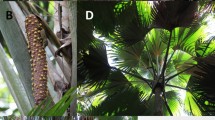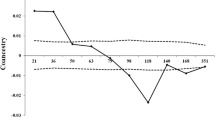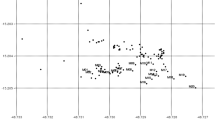Summary
We conducted a controlled crossing experiment to examine the effects of maternal and paternal parentage, the size of the pollen load, and prior fruit production on the proportion of flowers that set fruit, seed number per fruit and seed weight in a natural population of Campanula americana. Effects due to the maternal parent were large for all measures of fruit and seed production, while the paternal parent had a significant effect only upon mean seed weight. As the number of prior fruits on the maternal plant increased the probability that a flower would produce a mature fruit, the number of seeds per fruit, and total seed weight per fruit all decreased. We found no effect of the size of the pollen loads used in this study on fruit or seed production. These results are consistent with those of other studies that suggest in natural plant populations maternal effects, especially environmental maternal effects, can have an overwhelming effect on fruit and seed production and on seed characteristics.
Similar content being viewed by others
References
Antonovics J, Schmitt J (1986) Paternal and maternal effects on propagule size in Anthoxanthum odoratum. Oecologia 69: 277–282
Baskin JM, Baskin CC (1984) The ecological life cycle of Campanula americana in northcentral Kentucky. Bull Torr Bot Club 111: 329–337
Bertin RI (1988) Paternity in Plants. In: Lovett-Doust J, Lovett-Doust I (eds) Plant Reproductive Ecology: Patterns and Strategies. Oxford University Press, New York pp 30–59
Bertin RI (1990) Effects of pollination intensity in Campsis radicans. Am J Bot 77: 178–187
Black JN (1958) Competition between plants of different initial seed size in swards of subterranean clover (Trifolium subterraneum L.) with particular reference to leaf area and light microclimate. Aust J Agric Res 7: 98–109
Charlesworth D, Charlesworth B (1987) Inbreeding depression and its evolutionary consequences. Ann Rev Ecol Syst 18: 237–268
Devlin BD (1989) Components of seed and pollen yield of Lobelia cardinalis: variation and correlations. Am J Bot 76: 204–214
Gawel NJ, Robacker CD (1987) Effect of pollen-style interaction on the pollen tube growth of Gossypium hirsutum. Theor Appl Genet 72: 84–87
Gleason HA, Cronquist A (1963) Manual of the Vascular Plants of Northeastern United States and Adjacent Canada. Van Nostrand, New York
Gross KL, Soule JD (1981) Differences in biomass allocation to reproductive and vegetative structures of male and female plants of a dioccious, perennial herb, Silene alba (Miller) Krause. Am J Bot 68: 801–807
Gross KL, Werner PA (1982) Colonizing abilities of “biennial” plant species in relation to ground cover: implications for their distributions in a successional sere. Ecology 63: 921–931
Kromer M, Gross KL (1987) Seed mass, genotype, and density effects on growth and yield of Oenothera biennis L. Oecologia 3: 207–212
Lee TD (1988) Patterns of fruit and seed production. In: Lovett-Doust J, Lovett-Doust L (eds) Plant Reproductive Ecology: Patterns and Strategies. Oxford University Press, New York
Lee TD, Bazzaz FA (1982) Regulation of fruit and seed production in an annual legume, Cassia fasciculata. Ecology 63: 1363–1373
Marshall DL, Levin DA, Fowler NL (1985) Plasticity in yield reponse to fruit production and date of fruit initiation in three species of Sesbania (Leguminosae). J Ecol 73: 71–81
Marshall DL, Ellstrand NC (1986) Sexual selection in Raphanus sativus: experimental data on non-random fertilization, maternal choice, and consequences of multiple paternity. Am Nat 127: 446–461
Mazer SJ (1987) Parental effects on seed development and seed yield in Raphanus raphanistrum: implications for natural and sexual selection. Evolution 41: 355–371
Mazer SJ, Snow AA, Stanton ML (1986) Fertilization dynamics and parental effects upon fruit development in Raphanus raphanistrum: consequences for seed size variation. Am J Bot 73: 500–511
Mitchell-Olds T (1986) Quantitative genetics of survival and growth in Impatiens capensis. Evolution 40: 107–116
Nakamura RR (1988) Seed abortion and seed weight variation within fruits of Phaseolus vulgaris: pollen donor and resource limitation effects. Am J Bot 75: 1003–1010
Nakamura RR, Stanton ML (1989) Embryo growth and seed size in Raphanus sativus: maternal and paternal effects in vivo and in vitro. Evolution 43: 1435–1443
Pfahler PL (1967) Fertilization ability of maize pollen grains. II. Pollen genotype, female sporophyte and pollen storage interactions. Genetics 57: 513–521
Price MV, Waser NM (1979) Pollen dispersal and optimal outcrossing in Delphinium nelsoni. Nature 277: 294–296
Quesada MR, Schlichting CD, Winsor JA, Stephenson AG (1991) Effects of genotype on pollen performance in Cucurbita pepo. Sex Pl Repro
Richardson TE, Stephenson AG (1989) Pollen removal and pollen deposition affect the duration of the staminate and pistillate phases in Campanula rapunculoides. Am J Bot 76: 532–538
Roach DA, Wulff RD (1987) Maternal effects in plants. Ann Rev Ecol Syst 18: 209–235
Rocha OJ, Stephenson AG (1990) Effect of ovule position on seed production, seed weight and progeny performance in Phaseolus coccineus L. (Leguminosae). Am J Bot 77: 1320–1329
SAS Institute (1985) SAS User's Guide: Statistics, 1985 Edition. SAS Institute, Inc., Cary, NC
Schaal BA (1980) Reproductive capacity and seed size in Lupinus texensis. Am J Bot 67: 703–709
Schlichting CD, Devlin B (1989) Male and female reproductive success in the hermaphrodite plant Phlox drummondii. Am Nat 133: 212–227
Shetler SG (1979) Pollen-collecting hairs of Campanula (Campanulaceae), I: Historical review. Taxon 28: 205–215
Silander J, Primack RB (1978) Pollination intensity and seed set in evening primrose (Oenothera fruticosa). Am Midl Nat 100: 213–216
Snow AA (1986a) Pollination dynamics in Epilobium canum (Onagraceae): consequences for gametophytic selection. Am J Bot 73: 139–151
Snow AA (1986b) Evidence for and against pollen tube competition in natural plant populations. In: Mulcahy DL, Mulcahy GB, Ottaviano E (eds) Biotechnology and Ecology of Pollen. Springer-Verlag, New York Berlin Heidelberg Tokyo, pp 417–422
Stanton ML (1984a) Developmental and genetic sources of seed weight variation in Raphanus raphanistrum L. (Brassicaceae). Am J Bot 71: 1090–1098
Stanton ML (1984b) Seed variation in wild radish: effect of seed size on components of seedling and adult fitness. Ecology 65: 1105–1112
Stanton ML, Bereczky JK, Hasbrouch HD (1987) Pollination thoroughness and maternal yield regulation in wild radish, Raphanus raphanistrum (Brassicaceae). Oecologia 74: 68–76
Stephenson AG (1981) Flower and fruit abortion: proximate causes and ultimate functions. Ann Rev Ecol Syst 12: 253–279
Stephenson AG (1984) The regulation of maternal investment in an indeterminate flowering plant (Lotus corniculatus). Ecology 65: 113–121
Stephenson AG (1991) The regulation of maternal investment in plants as illustrated by Cucurbita pepo. In: Marshall C (ed) SEB Seminar Series. Environmental Physiology and Ecology of Fruits and Seed Production. Cambridge University Press. Cambridge
Stephenson AG, Devlin BD, Horton JB (1988a) The effects of seed number and prior fruit dominance on the pattern of fruit production in Cucurbita pepo (zucchini squash). Ann Bot 62: 653–661
Stephenson AG, Winsor JA, Schlichting CD, Davis LE (1988b) Pollen competition, nonrandom fertilization, and progeny fitness: a reply to Charlesworth. Am Nat 132: 303–308
Winsor JA, Davis LE, Stephenson AG (1987) The relationship between pollen load and fruit maturation and the effect of the pollen load on offspring vigor in Cucurbita pepo. Am Nat 129: 643–656
Author information
Authors and Affiliations
Rights and permissions
About this article
Cite this article
Richardson, T.E., Stephenson, A.G. Effects of parentage, prior fruit set and pollen load on fruit and seed production in Campanula americana L. Oecologia 87, 80–85 (1991). https://doi.org/10.1007/BF00323783
Received:
Accepted:
Issue Date:
DOI: https://doi.org/10.1007/BF00323783




